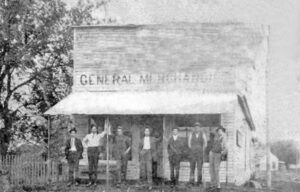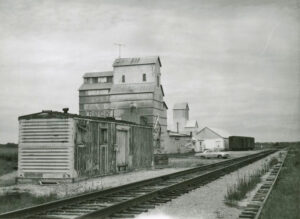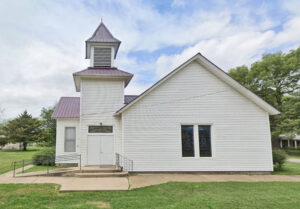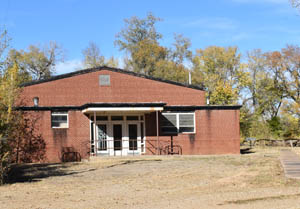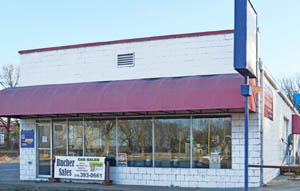Rock, Kansas, is an unincorporated village on the Walnut River in Rock Creek Township of Cowley County. As of the 2020 census, the community’s population and nearby areas was 94.
The community started in 1869 when settlers began homesteading the area. Among the first families were James B. Wall, E.A. Houser, and Martin Martindale. Martindale built a cabin, broke ground for 15 acres of corn, and had a fine herd of 300 Texas cattle.
Others coming in 1870 were George Worners, J.M. Harcourt, Josiah Houser, and George H. Williams. They were among those who organized the Methodist Episcopal Church and were elected trustees. That year, Rock Creek Township’s population was 160.
Others who appeared in Rock about this time were the families of J.R. Richards, George Walker, John Stalter, Andrew Dawson, J.R. Holmes, C.S. Widner, Mahlon Fatout, and T.F. Harp.
A post office was established on August 12, 1870, with its first Postmaster, Oliver G. Ross. Unfortunately, the post office closed on June 2, 1871. It reopened on June 7, 1872. For many years, the post office was located in various mercantile stores.
In 1877, the Florence, El Dorado, and Walnut Valley Railroad Company built a branch line from Florence to El Dorado. In 1881, it was extended to Douglass and later to Arkansas City. The Atchison, Topeka & Santa Fe Railroad leased and operated the line.
Rock Creek Township’s population rose to 1,170 in 1880. In 1882, Rock boasted a post office, a blacksmith shop, a wagon shop, a grocery store, and a stone quarry. The first school stood one-quarter mile north of the present location of the town site.
The second school building was constructed in 1885, a two-story brick structure used for many years. The railroad began to build through the area in 1885, with its end of track at Douglass, about five miles away in Butler County. Hiram T. Fisk was the first Depot agent. Draymen, who owned a wagon and a team of horses, hauled the bulk of supplies from the depot to area stores. Before the depot was established, the mail was delivered to Rock by horseback from Douglass.
The Rock United Methodist Church began meeting in the Rock school in1887.
Soon, more businesses were established in Rock, including a hardware store, telephone exchange, implement company, Christian Church, creamery, a produce house, general store, stockyards, a butcher shop, the Long-Bell Lumber Yard, and several service stations.
Around the turn of the century, the first grain elevator, called Bartlett Grain Company, was managed by F.R. Starkey.
A supplement to the Winfield Daily Courier of March 14, 1901, described Rock as an important trading point on the Florence Branch of the Atchison, Topeka & Santa Fe Railroad.
The United Methodist Church was constructed in 1902.
In 1905, the nearby Bucher Bridge, on the National Register of Historic Places, was built.
In 1910, Rock had retail stores, churches, public schools, telegraph and express offices, and a money order post office with one rural route. The population in 1910 was 150.
In 1911, the Rock State Bank was organized.
The Rock Reporter newspaper was briefly published from August 8, 1913, to October 17, 1913. It was first printed from a press in the back of a stone store, then moved to a store building near the Rock State Bank. The first issue was eight pages, and the last issue was one page. From about 1915 into the early 1920s, the Palace Hotel was operated by John Everett and Daisy Brown Parsons. The hotel stood on the southeast corner of the town. It consisted of two stories, with the front door facing north; the main floor had a large dining room and kitchen and a place for a daybed. The second floor had five sleeping rooms. Some of the patrons were oil field and road construction workers.
In 1923, Rock was entirely surrounded by flood waters. That year, oil was discovered east of town. In 1925, the entire southeast portion of the business section burned in an Easter morning fire.
The Palace Hotel closed in 1929. A few years later, Rolla Kunkel moved his creamery into the building.
During the Great Depression, the Rock State Bank closed in 1933 when it was discovered that a shortage of about $11,200 existed. Depositors recovered about 80 cents on the dollar.
The railroad line from Florence to El Dorado was abandoned in 1942. The original branch line connected Florence, Burns, De Graff, El Dorado, Augusta, Douglass, Rock, Akron, Winfield, and Arkansas City.
In 1960, a larger school building and gym were constructed on the same site as the previous school.
On August 24, 1978, the community was evacuated when a major oxidizer spill at a Titan II ICBM site 2.5 miles south of Rock. The spill resulted in the deaths of two airmen based out of the 381st Strategic Missile Wing, McConnell Air Force Base, approximately 20 miles away.
By 1985, Rock Creek Township’s population had decreased to around 260.
In 2010, the Keystone XL Pipeline was constructed about 2.5 miles west of Rock, north to south through Butler County, with much controversy over tax exemption and environmental concerns. A pumping station named Rock was built along the pipeline.
The community is served by Udall USD 463 public school district.
Rock is 15 miles north of Winfield and about 30 miles southeast of Wichita.
©Kathy Alexander/Legends of Kansas, updated January 2024.
Also See:
Sources:
Blackmar, Frank W.; Kansas: A Cyclopedia of State History, Vol I; Standard Publishing Company, Chicago, IL 1912.
Kansas Gen Web
Wikipedia


